

Is the full-time American job going the way of the dodo? The signs aren’t exactly heartening.
Consider the jobs report released Friday [July 5]. The United States added 195,000 new jobs in June, it said, including 322,000 new part-time jobs — a number that comprises only part-timers who want full-time work but can’t find it. Assuming my grade-school arithmetic skills haven’t completely eroded, that suggests that the number of full-time jobs actually declined.
Critics of Obamacare have a ready explanation: The 30-hour-a-week cutoff of the now-postponed employer mandate — which requires many employers to either provide health-care coverage for employees who work at least that much or to pay a penalty — was compelling employers to reduce workers’ hours. That mandate, the Wall Street Journal editorialized, gave businesses “an incentive to hire more part-time workers.”
If the employer mandate really were the problem,
» Read more about: The Full-Time Worker: A Vanishing American »
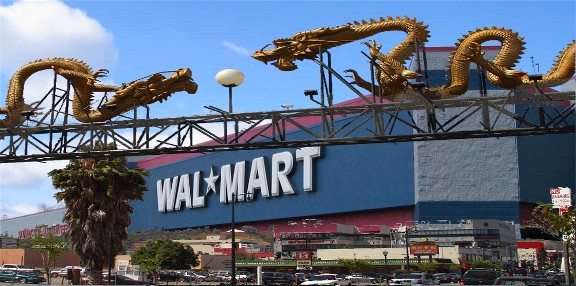

Tomorrow the fate of Chinatown residents and small businesses will be decided by the Superior Court. For the past 18 months, Chinatown residents and community activists across the city have been fighting Walmart’s attempt to open a grocery store in the historic downtown neighborhood. Now a judge will weigh the right of Asian-American communities to have a voice in what is built in their neighborhoods versus a multinational corporation’s ability to open just one more store. The lawsuit filed by the Asian Pacific American Labor Alliance (APALA) and its allies seeks to nullify the building permits granted to Walmart by L.A. city officials.
As we at APALA prepare for the trial, I have been reflecting on our civil rights and labor struggles in the Asian-American community. It’s the same battle that Chinatown residents fought against Union Station displacement and that Japanese Americans fought to reclaim Little Tokyo in the wake of internment camps and recent gentrification.


I recently had the privilege of attending a banquet recognizing Walmart workers who have dedicated themselves to winning policy changes that affect the way they are treated by this retail giant. The event was held at the First AME Church of Los Angeles, which has been in the forefront of fighting for civil rights and social justice.
Many stories shared by the workers reflected the nightmare that is their Walmart employment experience. One very nervous young woman spoke of being seriously injured when luggage from a storage rack fell on her back. Her supervisors refused to administer medical attention or even call for an ambulance; she had to drive herself to a hospital.
There are warehouse workers at subcontracted facilities who find themselves working in trailers whose temperatures reach more than 100 degrees – such workers are faced with limited water availability and supervisors who don’t permit frequent breaks for employees to cool down.
» Read more about: Walmart Employees Recount Grim Working Environment »


David Acosta, a leader in the fight to improve warehouse working conditions, is back to work today. David was fired from his job as a forklift driver at a critical Walmart-controlled warehouse in Mira Loma, California at the end of May for allegedly violating a safety policy. David and his coworkers fought back against his unfair dismissal and retaliation by the warehouse operator, Schneider Logistics, for helping expose wrongdoing at the warehouse.
David is a lead plaintiff in a massive federal lawsuit that exposed millions of dollars in stolen wages. The lawsuit, of which Walmart, Schneider and the temporary staffing agencies that employed warehouse workers are defendants, helped end decades-long scheme to defraud workers.
“We know that Walmart is in control and now we will know the extent of their involvement to defraud workers,” Acosta said of the lawsuit.
In October 2011, workers who were jointly employed at the Walmart warehouses by Schneider Logistics,


Walmart’s expansion strategy for Los Angeles and other urban areas has been to avoid public oversight by choosing real estate that doesn’t require public review – and, where possible, to secure public subsidies, often with little public scrutiny.
This is exactly what happened in both Covina and Cathedral City. In 1993, Walmart negotiated an intricate deal with the City of Covina’s redevelopment agency that resulted in the company making a tidy profit of $4.1 million. Walmart made a $10.8 million loan to the CRA to purchase several plots of land for the corporation, which was then sold back to Walmart at the discounted price of $6.7 million. In this way, Walmart effectively received a $4.1 million subsidy from taxpayers to develop the land. Similarly, in 1995, Walmart was reimbursed by Cathedral City for $850,000 for “infrastructure improvements,” but on the day that taxpayers recovered this subsidy,
» Read more about: Unlevel Playing Field: How Taxpayers Foot Walmart’s Bills »
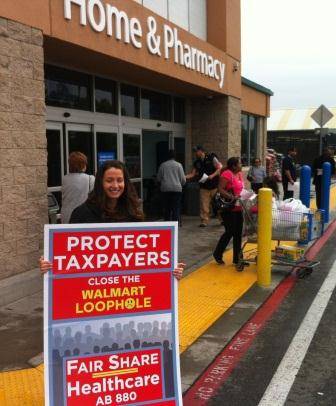

We all know that working for Walmart is no picnic. They pay low wages, they slash hours, they offer little or no job security, they exploit and intimidate workers and they use sweatshop labor. That’s why Walmart workers are on strike this week, to protest the corporation’s greedy behavior and shady business practices. Learn more about the strike here.
Many of these striking workers earn so little that they’re eligible for public assistance, like food stamps and Medicaid. And that’s no accident; it’s exactly the way Walmart likes it. We as taxpayers foot the bill for their workers, and the corporate head honchos get even richer.
According to a new report released today by the California Works Foundation:
[Walmart] workers use 40% more public health care assistance than the retail average. The company’s use of public assistance costs California $86 million per year,
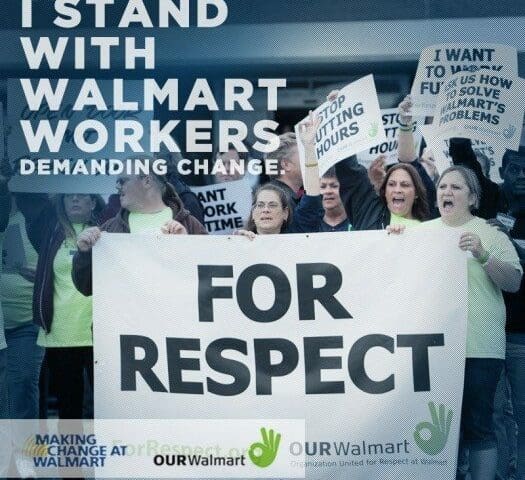

This week, Frying Pan News has been following stories as Walmart workers joined caravans coming from across the country, converging at the company’s annual shareholders meeting in Bentonville, Arkansas. This post originally appeared on MakingChangeAtWalmart.org. Video of the action is here.
What a week! After an action-packed journey, the six Ride for Respect caravans all arrived safely in Bentonville, Arkansas over the weekend. But the buses of #Walmartstrikers were not about to sit around until Friday, when Walmart’s annual shareholders meeting will take place–that’s for sure!
[Mon] morning, a group of 200 OUR Walmart members and supporters marched through the misty dawn to Walmart’s Home Office, and arrived just as the employees at the headquarters were filing into work. Quietly, the throngs of green shirts spread out in front of Home Office–many in the crowd had tape-covered mouths with “ULP strike” written across,
» Read more about: Action at Walmart’s Home Office as Caravans Arrive in Bentonville! »


For several years, Walmart’s annual shareholders meeting has been the staging ground for high-profile protests against the retail giant’s treatment of its employees. As Walmart workers from across the country — many of whom are on strike — once again converge this week on the corporation’s headquarters in Bentonville, Arkansas, one startling fact stands out: none of them, or any of the retail giant’s 1.4 million workers, are represented by a union.
Walmart’s success in keeping its American workforce entirely nonunion is, of course, well documented — so much so that observers of the company’s chronic labor strife almost take it for granted. But even in the context of a long national decline in union membership among American workers, it is staggering that the country’s largest employer, and one of its stingiest, has remained union free.
While Walmart contends that its employees have no use for union representation,
» Read more about: Walmart’s War Against Unions — and the U.S. Laws That Make It Possible »
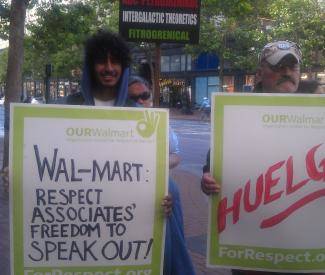

There are no Walmart stores in San Francisco. And yet, four members of the company’s board of directors are influential Bay Area residents. On May 29, a group of Walmart workers assembled outside the residence of Yahoo! CEO Marissa Mayer, a Walmart director, who has a 38th floor penthouse apartment above the Four Seasons on Market Street in San Francisco.
Donning bright green T-shirts and chanting, “Stand up, live better,” the workers were gearing up to join roughly 100 members of OUR Walmart, a nationwide organization of Walmart associates, in going on strike and caravanning to Bentonville, AR, where the retailer will hold its annual shareholder meeting June 7.
OUR Walmart’s stated concerns include things like giving employees the option of working full-time, and providing a level of wages and benefits that ensures employees aren’t forced to rely on government assistance to get by.
Dominic Ware,
» Read more about: Walmart Workers Strike, Rally Outside Marissa Mayer’s SF Penthouse »
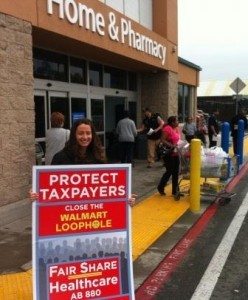
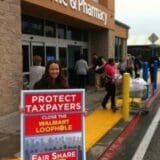
Dozens of Stockton-area workers and seniors streamed into the parking lot of the Walmart Supercenter [Thursday] morning to deliver an important message: Walmart must pay its fair share for health care.
It was the second stop on the statewide “Close the Walmart Loophole” tour.
Not even the grey sky or the rainy weather could dampen the spirits of the members of AFSCME [American Federation of State, County and Municipal Employees], UFCW [United Food and Commercial Workers], Teamsters and other unions and seniors from the California Association of Retired Americans who all came together to fight for what is right for taxpayers.
Richard Andazola, President of the San Joaquin-Calaveras Central Labor Council:
“We’re here to send a message that a few big corporations like Walmart shouldn’t get to evade the law just because they have an army of lobbyists on their side.
» Read more about: Stockton Workers and Seniors Fight “Walmart Loophole” »


[Frying Pan News Note: A New York Times piece posted last night by Steven Greenhouse — and referenced below — revealed that “newly found documents indicate that apparel had been produced for Walmart at one of the operations in the factory building that collapsed last month.”]
The most dangerous job in the world, outside war zones, isn’t that of an undercover police officer or a firefighter or a bullfighter or aerialist. It’s sewing garments — particularly in Bangladesh.
The death toll in the April 24 collapse of Rana Plaza has topped 1,100 and continues to rise. But Rana Plaza is merely the most deadly of an unbroken string of preventable disasters that have plagued garment manufacturing in Bangladesh, the world’s second-largest exporter of clothing, behind only China. It’s not even the most recent preventable disaster: Since the cataclysmic building collapse,
» Read more about: Harold Meyerson: Walmart and Bangladesh’s Death Traps »
Yesterday members of Warehouse Workers United and their supporters confronted Scot Rank, the CEO of scandal-plagued Walmart de Mexico, at UCLA’s Anderson School of Business. The warehouse employees are fighting for improved working conditions at warehouse facilities operated by Walmart contractors. This raw video captures the protest.
» Read more about: Walmart de Mexico CEO Confronted at UCLA »


(Note from Warehouse Workers United: Please take action now — workers like Javier, whose blog appears below, should not be fired with impunity. We will deliver this petition to Walmart today, April 29, 1 p.m., PDT.)
One month ago my son Alex was born. Yesterday I was fired from my job as a forklift driver at a warehouse where we move 100 percent Walmart merchandise.
I am outspoken. I defend my coworkers. I alert management about broken and unsafe equipment. I teach my coworkers about their rights, like what minimum wage is and what they should do when they are injured on the job.
I have been a target of management for a while. They watch everything I do, but it’s not my nature to be silent or scared. I know when I am right. Last year I went on strike to protest the retaliation my coworkers experienced when they spoke to the media and the public about the dirty water (if we had any water at all) that we were given to drink,
» Read more about: Help Reinstate Walmart Contract Worker Javier Rodriguez »


If you’re like me, right now you may be scrambling to stock up on all of your Passover essentials. So what if I told you that you could get 12 boxes of matzah – more than enough to cover the eight days and nights of breadless revelry – for just over $40 bucks?
Ah, but there’s a catch: You’ll have to buy this miracle matzah pak at Walmart. Moral dilemma? You bet.
Last year we provided a short list of reasons you might want to think twice about a Walmart matzah binge. We wish we could report that Walmart had cleaned up its act since then, but alas, the world’s largest retailer has racked up a series of alleged corporate crimes and indiscretions that would make a pharaoh blush.
So before you succumb to those everyday low prices, here are five more reasons not to buy matzah at Walmart:
1) Hunger Strike: Remember those passages in the haggadah about the bread of affliction?
» Read more about: Five New Reasons Not to Buy Matzah at Walmart »


If you watched any one of the recent Los Angeles mayoral debates, you likely concluded that the biggest issue in this election is who voters can trust to get the city’s fiscal house in order.
But what does it really mean to be a good fiscal watchdog in the city of Los Angeles? As a long-time city commissioner and community leader, I have found that the biggest demonstration of strong leadership is the willingness to stand up to the powerful corporate interests and their lobbyists, who continue to dominate most of the decisions made at City Hall.
In 2012, “clients” spent more than $35 million on lobbyists hired to influence City Hall decision-makers. For-profit corporations accounted for more than $31 million of that. Unions spent less than $700,000 on paid lobbyists. The list of companies paying lobbyists to represent their interests at City Hall is a Who’s Who of corporate America.
» Read more about: Our Next Mayor Must Stand Up to Corporate Lobbyists »


For years, Los Angeles has been ground zero in an intense debate about how to improve our nation’s education system. What’s less known is who is shaping that debate. Many of the biggest contributors to the so-called “school choice” movement — code words for privatizing our public education system — are billionaires who don’t live in Southern California, but have gained significant influence in local school politics. New York Mayor Michael Bloomberg’s recent contribution of $1 million to a political action committee created to influence next week’s LAUSD school board elections is only the most recent example of the billionaire blitzkrieg.
For more than a decade, however, one of the biggest of the billionaire interlopers has been the Walton family, heirs to the Walmart fortune, who have poured millions into a privatization-oriented, ideological campaign to make L.A. a laboratory for their ideas about treating schools like for-profit businesses,
» Read more about: Walmart Heirs Spend Millions to Privatize L.A. Schools »


We are workers who move Walmart merchandise at a private warehouse in Chino, California. Just a couple of weeks ago the state of California ordered the warehouse owner to repay us more than $1 million in stolen wages. The California Labor Commissioner determined the warehouse operator, Quetico LLC, had shorted our paychecks and those of more than 800 workers.
Para leer en Español haz cliq aquí.
We are so happy that justice has been served, but we continue to risk our jobs just because we blew the whistle. The company is denying it did anything wrong and appealing the state’s ruling. In the meantime we are worried about retaliation and losing our jobs. We don’t know if we will be fired. Walmart has done nothing.
You can help us. Sign our petition to Walmart.
» Read more about: Petition: Walmart-Contract Workers Fear Retaliation »


Most of us know how badly Walmart treats its employees. Yet whenever the remedy of paying a living wage is proposed, opponents always argue that the cost to Walmart shoppers is too high, and that low-income consumers will be hurt the most.[1]The question is: What will a living wage for Walmart workers cost Walmart shoppers?
First, some background. A 2005 study found that Walmart jobs in metropolitan areas pay less and are less likely to offer benefits. Other researchers demonstrated that Walmart workers earn on average 31 percent less than workers in large retail stores as a whole and about 60 percent of the wages of unionized workers. They also found that an astounding 75 percent of full-time workers with at least one year on the job made below $10 an hour and less than half were enrolled in Walmart’s cost-prohibitive health plan.
Moreover,
» Read more about: Walmart: The Low Cost of High Road Retailers »


The state of California has ordered a Southern California warehouse that processes merchandise for Walmart and other retailers to pay 865 workers more than $1 million in stolen wages.
The California Division of Labor Standards Enforcement issued the citations Monday, Jan. 28 against Quetico, LLC, a large warehouse complex in Chino, California. Back wages and unpaid overtime total more than $1.1million and in addition the state issued about $200,000 in penalties.
“Quetico is strict when it comes to enforcing its rules with workers so it is only fair that the state enforce the laws that the company broke,” said Abraham Guzman, a warehouse worker who has been at Quetico for about two and a half years. “I am satisfied that the law will now be followed and workers have won justice.”
Last year workers brought concerns to the Warehouse Worker Resource Center, an advocacy organization that works with Warehouse Workers United.
» Read more about: State Hits Walmart Contractor With Wage-Theft Ruling »


Last year, Walmart gave $918,000 through its foundation to 33 California nonprofits. Amongst the types of organizations: job training, homeless shelters and health groups (see list below).
I scratched my head when I read this. Of course we want to see vital social service groups impacted by severe government funding cuts survive in this economy. Many of us have attended fundraisers for, or donated to these groups ourselves.
But there was something about the nature of the groups that caught my eye. I wondered: Why is Walmart funding groups that provide for such basic needs? Why is a corporation suddenly funding healthcare groups? Altruism? A love for Obamacare? Or is there something else?
Here’s what strikes me about Walmart’s seemingly benign charity efforts: The type of groups they’re funding addresses basic needs (jobs, health, shelter) that good jobs actually fulfill. Walmart, of course, is notorious for not providing such jobs.
» Read more about: Walmart’s Philanthropy Model: Charity and Poverty »